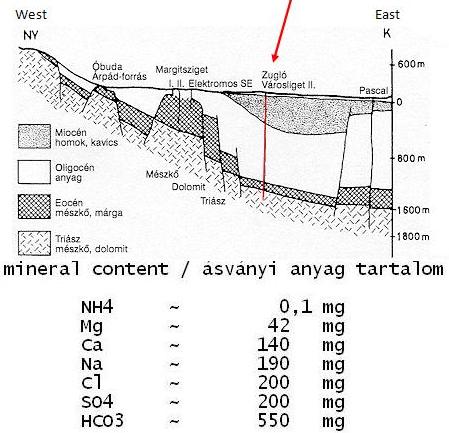Saint Stephen Well Nr.II EarthCache
-
Difficulty:
-

-
Terrain:
-

Size:  (not chosen)
(not chosen)
Please note Use of geocaching.com services is subject to the terms and conditions
in our disclaimer.

The Széchenyi Thermal Bath is one of the largest spa complexes in Europe. It's also the first thermal bath of Pest. It owes its existence to Vilmos Zsigmondy, a mining engineer. on his initiative, successful deep borings had been performed in the City Park, where later, in 1881 already an "Artesian bath" was in operation. However, this temporary type of bath was meeting the demands of the age less and less, so the Széchenyi Thermal Bath was built in 1913 on the basis of plans composed by Gyozo Czigler. The Bath was expanded in 1927 with a public bathing department for gentlemen and ladies and a beach site. In the middle of the 1960s, further transformations took place, including the creation of a group thermal section in bathing suits as well as a daytime outpatient hospital (complex physiotherapy department).
The reconstruction of the pools of the swimming section, their equipment with water filtering and circulation devices was completed in 1999. The so-called fancy bath includes a whirling corridor, underwater effervescence production, neck shower, water beam back massage installed in the sitting banks and many other services.
The water supply for the Széchenyi Thermal Bath is provided by the Saint Stephen Well Nr.II commissioned in 1938. It is a hot-spring water with calcium, magnesium, hydro-carbonate, also containing sodium and sulphate, with a significant content in fluoride and metaboric acid.
Therapeutic suggestions:
- degenerative joint diseases
- chronic and sub-acute arthritis
- orthopedic and post-accident treatments
Diagnoses required for drinking cure:
- chronic gastric catarrh, gastric ulcer, intestinal catarrh
- overproduction of gastric acid
- chronic inflammation of the pelvis of the kidney and of the urine paths
- certain forms of renal stone illnesses
- chronic catarrh of the inhaling organs
- influencing disturbances of metabolism linked to gout
- in case of certain illnesses of the gall-bladder and the gall paths, for enhancing gall-discharge
The water can be tasted in drinking hall.
The Budapest Zoo and Botanical Garden hippos bathing water gets out of here, because its chemical composition is similar to the composition of the water of the Nile.
This is Europe's hottest sulphurous healing water.

To log yor visit, please.
Send your answers via e-mail to me...
Please don’t give answers in your log !
1, The number of gray columns within the drinking hall ?
2, What is the mineral content of a liter of water ( mg ) ?
3, The temperature of the thermal water ( C° ) ?
Uploaded photos with you and/or your GPS in the background with the drinking hall are welcome.
-----------------------------------------------------------------------
A Széchenyi Fürdo Európa egyik legnagyobb fürdokomplexuma, Pest elso gyógyfürdoje. Létét Zsigmondy Vilmos bányamérnöknek köszönheti. Kezdeményezésére sikeres mélyfúrásokat végeztek a Városligetben, ahol késobb, 1881-ben már "Artézi fürdo" muködött, azonban az ideiglenes jellegu fürdo egyre kevésbé felelt meg a kor igényeinek. Így épült fel 1913-ban Czigler Gyozo tervei alapján a Széchenyi Gyógyfürdo. A fürdo 1927-ben férfi és noi népfürdoosztállyal és strandfürdovel bovült. Az 1960-as évek közepén további átalakításokra került sor, társas fürdoruhás termálosztály létesült. Az uszoda medencéinek rekonstrukciójára, szuroforgató-berendezéssel történo ellátására 1999-ben került sor. Az ún. élménymedencében megtalálható a sodrófolyosó, a víz alatti pezsegtetés, a nyakzuhany, az ülopadokba rejtett, hátat masszírozó vízsugár és még sok más, eddig kevésbé ismert szolgáltatás.
A Széchenyi Fürdö vízellátását az 1938-ban átadott II. számú Szent István-kút biztosítja. Nátriumot is tartalmazó kalcium-magnézium-hidrogénkarbonátos, szulfátos hévíz, melynek fluorid- és metaborsav-tartalma is jelentos.
Gyógyjavallatok:
- Ízületek degeneratív betegségei
- Idült és félheveny ízületi gyulladások
- Ortopédiai, baleseti utókezelések
Az ivókúra javallatai:
- idült gyomorhurut, gyomorfekély, bélhurut
- gyomorsavtúltengés
- a vesemedence és a húgyutak idült gyulladásai
- a vesekobetegség egyes formái
- légzoszervek idült hurutai
- köszvényes anyagcserezavar befolyásolása
- az epehólyag és epeutak egyes megbetegedései esetén az epeürülés elosegítése
A gyógyvíz megkóstolható az ivócsarnokban.
A Fovárosi Állat- és Növénykert vízilova innen kapja fürdövizét, mivel annak vegyi összetétele hasonlít a Nílus vizének összetételéhez.
Ez Európa legmelegebb kénes gyógyvize.

A logoláshoz kérlek…
Küldd el a válaszokat számomra e-mailben...
Kérlek, ne adj meg választ a logban !
1, Az ivocsarnokon belül található szürke oszlopok száma ?
2, Mennyi az ásványi anyag tartalma egy liter víznek ( mg ) ?
3, A termálviz homérséklete?
Ha van kedved, tölts fel fotót magadról és/vagy a GPS-edröl, az ivócsarnokkal a háttérben.

Additional Hints
(Decrypt)
[ ENG : ] 1, gjb qvtvgf / 2-3 zneoyr cyng ol gur cbby fvqr
[ HUN : ] 1, xég fmázwrtl / 2-3 záeiáal gáoyn n zrqrapr byqnyáa